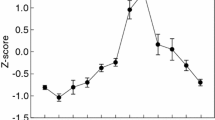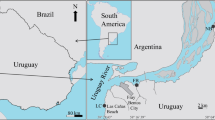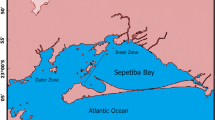Abstract
In this study we examined differences in feeding behevior of populations of the marine temperate herbivorous fish Aplodactylus punctatus, in three different localities off the Chilean coast, which differ qualitatively and quantitatively in food availability. We test whether food selection follows optimal foraging strategics, whether there is any modification of the fishes' digestive tracts in relation to their diets, and whether differences in diet quality affect the allocation of energy into reproduction and maintenance in these populations. Samples of this fish and of the understore algal assemblages were taken seasonally from May 1989 to February 1990. For each population we analyzed dietary composition, weight of the digestive tract and of the food content, the condition factor (K), and the gonadosomatic index (GSI). Our results showed that the diet observed in the three populations closely resembled the differences in macro-algal abundance and composition among the three localities studied. Local differences in diet quality were inversely related to the amount of food consumption and size of the digestive tract, suggesting that under differential conditions of food availability A. punctatus is able to compensate for variations in food quality through a flexibility in its digestive strategies. The nutritional status (K) of individuals, and their reproductive pattern (GSI) were directly related to diet quality. These results indicate that although A. punctatus is able to adjust its digestive processes to different algal food regimes, the digestive modifications observed in food-poor environments are not sufficient to compensate for the lack of food and allow fish to reach the nutritional status and reproductive output reached in a food-rich environment. This study represents the first natural experiment demonstrating a direct relationship among food availability, feeding patterns, digestive processes, and reproductive effort.
Similar content being viewed by others
References
Belovsky GE (1984) Herbivore optimal foraging: a comparative test of three models. Am Nat 124: 97–115
Benavides AG, Cancino JM, Ojeda FP (1994a) Ontogenetic change in the diet of Aplodactylus punctatus (Pisces: Aplodactylidae): an ecophysiological explanation. Mar Biol 118: 1–5
Benavides AG, Cancino JM, Ojeda FP (1994b) Ontogenetic changes in gut dimensions and macroalgal digestibility in the marine fish Aplodactylus punctatus. Funct Ecol 8: 46–51
Bjorndal KA (1991) Diet mixing: non-additive interactions of diet items in a omnivorous freshwater turle. Ecology 72: 1234–1241
Bozinovic F, Veloso C, Rosenmann M (1988) Cambios del tracto digestivo de Abrothrix andinus (Cricetidae): efecto de la calidad de la dieta y requerimientos de energía. Rev Chil Hist Nat 61: 245–251
Cáceres CW, Benavides AG, Ojeda FP (1993) Ecología trófica del pez herbívoro Aplodactylus punctatus (Pisces: Aplodactylidae) en la costa centro-norte de Chile. Rev Chile Hist Nat 66: 185–194
Camus PA, Ojeda FP (1992) Scale-dependent variability of density estimates and morphometric relationships in subtidal stands of the kelp Lessonia trabeculata in northern and central Chile. Mar Ecol Prog Ser 90: 193–200
Chirichigno N (1974) Clave para identificar los peces marinos del Perú. Informe Instituto del Mar del Perú, Callao 44: 1–387
Green DA, Millar JS (1987) Changes in gut dimensions and capacity of Perumyscus maniculatus relative to diet and energy needs. Can J Zool 65: 2159–2162
Gross JE, Wang Z, Wunder BA (1985) Effects of food quality and energy needs: changes in gut morphologhy and capacity of Microthus ochrogaster. J Mammal 66: 661–667
Fishelson L, Montgomery LW, Myrberg AH Jr (1987) Biology of surgeonfish Acanthurus nigrofuscus with emphasis on change-over in diet and annual gonadal cycles. Mar Ecol Prog Ser 39: 37–47
Freeland WJ, Janzen DH (1974) Strategies in herbivory by mammals: the role of plant secondary compounds. Am Nat 108: 269–289
Fuentes LS, Cancino JM (1990) Cambios morfométricos en el tubo digestivo de juveniles de Girella laevifrons (Kyphosidae) en función de la dieta y del nivel de repleción. Rev Biol Mar Valparaíso 25: 19–26
Karasov WH (1990) Digestion in birds: chemical and physiological determinants and ecological implications. Stud Avian Biol 13: 391–415
Karasov WH, Diamond JM (1983) Adaptative regulation of sugar and amino acids transport by vertebrate intestine. Am J Physiol 245: 443–462
Karasov WH, Diamond JM (1988) Interplay between physiology and ecology in digestion. Bioscience 38: 602–611
Kitting CL (1980) Herbivore-plant interaction of individual limpet maintaining a mixed diet of intertidal marine algae. Ecol Monogr 50: 527–550
Horn MH (1983) Optimal diets in complex environments: feeding strategies of two herbivorous fishes from a temperate rocky intertidal zone. Oecologia 58: 345–350
Horn MH (1989) Biology of marine herbivorous fishes. Oceanogr Mar Biol Annu Rev 27: 167–272
Hughes RN (1980) Optimal foraging theory in the marine context. Oceanogr Mar Biol Ann Rev 18: 423–481
Matson WJ (1980) Herbivory in relation to plant nitrogen content. Annu Rev Ecol Syst 11: 119–161
Miranda O (1973) Calendario ictiológico de San Antonio. 3. Biología de la Jerguilla (Aplodactylus punctatus). Biol Pesq Chile 6: 25–43
Montgomery WL, Gerking SD (1980) Marine macroalgae as food for fishes: an evaluation of potential food quality. Env Biol Fish 5: 143–153
Montgomery WL, Myrberg AA Jr, Fishelson L (1989) Feeding ecology of surgeonfishes (Acanthuridae) in the northern Red Sea, with particular reference to Acanthurus nigrofuscus (Forsskal). J Exp Mar Biol Ecol 132: 179–207
Ojeda FP, Dearborn JH (1989) Community structure of macroin-vertebrates inhabiting the rocky subtidal zone in the Gulf of Maine: seasonal and bathymetric distribution. Mar Ecol Prog Ser 57: 147–161
Paine RT, Vadas RL (1969) Caloric values of benthic marine algae and their postulated relation to invertebrate food preferences. Mar Biol 4: 79–86
Penry DL, Jumars PA (1986) Chemical reactor theory and optimal digestion. BioScience 36: 310–315
Pringle JD (1984) Efficiency estimates for various quadrat sizes used in benthic sampling. Can J Fish Aquat Sci 41: 485–489
Pyke GH (1984) Optimal foraging theory: a critical review. Ann Rev Ecol Syst 15: 523–538
Pyké GH, Pullian HR, Charnov EL (1977) Optimal foraging: a selective review of theory and tests. Q Rev Biol 52: 137–152
Savory CJ, Gentle MJ (1976) Change in food intake and gut size in japanese quail in response to manipulation of dietary fibre content. Brit Poult Sci 17: 571–580
Schluter D (1981) Does the theory of optimal diets apply in complex environments? Am Nat 109: 765–768
Sibly RM (1981) Strategies in digestion and defecation. In. Townsend CR, Calow P (eds) Physiological ecology: an evolutionary approach to resource use. Blackwell, Oxford, pp 109–139
Sibly RM, Calow P (1986) Physiological ecology of animals: an evolutionary approach. Blackwell, Oxford
Siegel S, Castellan NJ (1988) Nonparametric statistics for the behavioral sciences. 2nd edn. McGraw-Hill, New York
Vadas RL (1985) Herbivory. In: Littler MM, Littler DS (eds) Handbook of phycological methods: ecological field methods: macroalgae. Cambridge University Press, Cambridge, pp 531–572
Weatherley AH (1972) Growth and ecology of fish populations. Academic Press, London
Westoby M (1974) What are the biological bases of varied diets? Am Nat 112: 627–631
Author information
Authors and Affiliations
Rights and permissions
About this article
Cite this article
Caceres, C.W., Fuentes, L.S. & Ojeda, F.P. Optimal feeding strategy of the temperate herbivorous fish Aplodactylus punctatus: the effects of food availability on digestive and reproductive patterns. Oecologia 99, 118–123 (1994). https://doi.org/10.1007/BF00317091
Received:
Accepted:
Issue Date:
DOI: https://doi.org/10.1007/BF00317091




